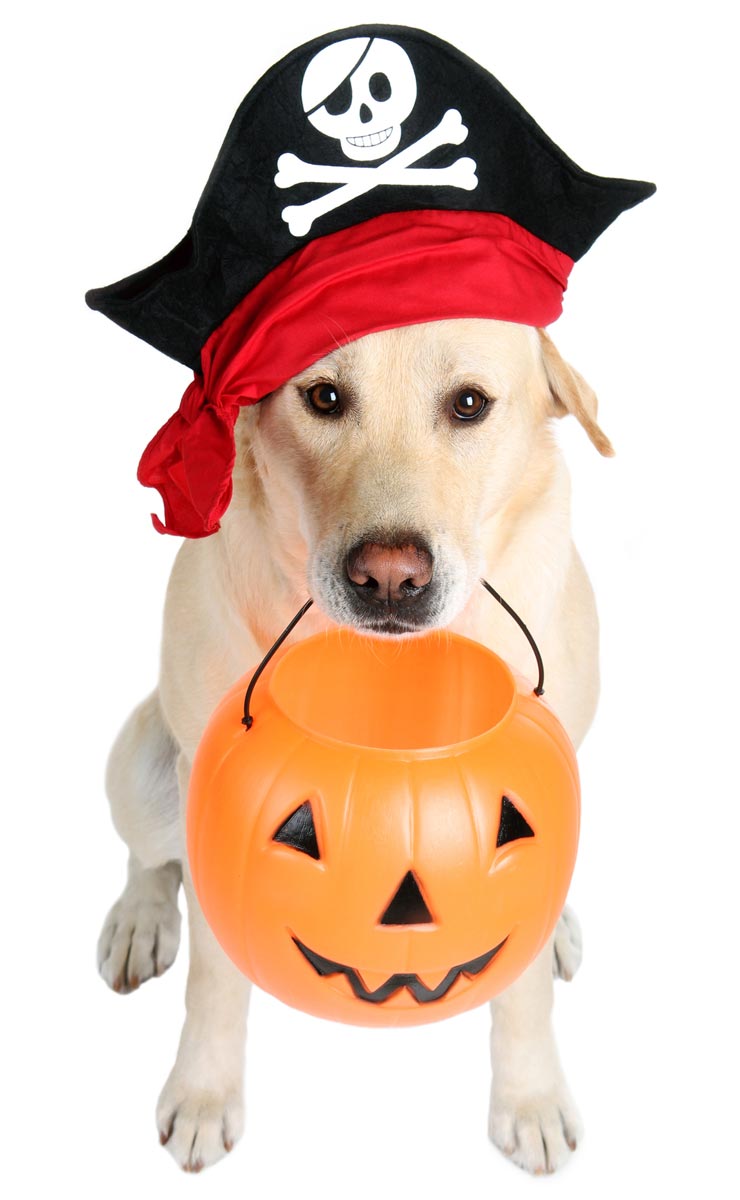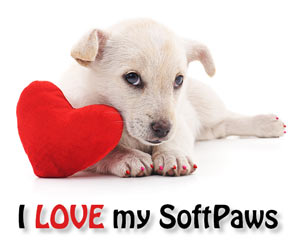Halloween Safety for Dogs

Halloween is just around the corner. And while it's an exciting time for little ghosts and goblins, it can cause quite a fright for your dog. Beware of these Halloween hazards so you can protect your pet.
Trick or Retreat!
Halloween is a highlight of the year for children and many adults, but your dog may not agree. An incessantly ringing doorbell, ghosts and ghouls on the porch, unaccustomed guests, and commotion both indoors and out—this can all be very stressful, even for the most laid-back dog. Canine escape artists might be tempted to sneak through open doors and gates to get away from the hubbub. Skittish dogs could be tempted to snap or bite at costumed people. Curious canines could brush by a candle or carved pumpkin, risking singed fur, burns, or starting a fire (you can learn more in our "Fire Safety for Dogs" article). Sadly, there is the rare disturbed individual looking to torture or abduct a family pet found alone outdoors around Halloween time.
Ensure your dog's comfort and safety around Halloween by keeping her indoors and placing her in a safe room or crate. Use a noise machine to mask sounds, try a soothing classical CD, pop in a "for dogs only" video, or turn on DogTV to distract her from the commotion outside. Consider giving your dog a new toy or, in particular, a Kong Blue toy to occupy her attention until the excitement subsides. Natural stress relievers such as Bach Flower Essence Rescue Remedy or comforting dog pheromone sprays, collars, or diffusers can be very efficacious as well. You can learn more about these in the article "How to Cope with Canine Anxiety and Fear by Using Adaptil(TM) (Formerly called D.A.P)." If you must take your dog outdoors, keep her close at hand and safely on a leash.
No Sweets for the Sweet!
The chocolate in candy and other goodies is probably the best-known Halloween hazard for dogs. Chocolate contains the stimulant theobromine, which is harmless to people but extremely toxic to dogs and other pets. The risk level depends on the type of chocolate, the size of the dog, and how much chocolate is ingested (see table). White chocolate and baked goods (brownies, cookies, cakes) contain lower levels of theobromine and are less hazardous. Milk chocolate contains more, and dark chocolate and baker's (unsweetened) chocolate contain the most. Small dogs are most at risk by virtue of their size. For instance, while a Hershey bar or two could give an 80-pound Labrador a tummy ache, it could be quite dangerous or deadly for a 10-pound poodle.
Toxic Doses of Chocolate by Dog's Weight
| Dog's Weight (lbs) | 10 | 20 | 30 | 40 | 50 | 60 | 70 | 80 | 90 | 100 |
| Milk Chocolate (oz) | 4 | 8.2 | 12.3 | 16.4 | 20.5 | 24.5 | 28.6 | 32.7 | 36.8 | 41 |
| Dark Chocolate (oz) | 1.4 | 2.8 | 4.2 | 5.5 | 6.9 | 8.3 | 9.7 | 11 | 12.5 | 13.8 |
| Baker's Chocolate (oz) | 0.5 | 0.9 | 1.4 | 1.9 | 2.3 | 2.8 | 3.2 | 3.7 | 4.1 | 4.6 |
Adapted from Chocolate Toxicity by Dr. Wendy Brooks, www.VeterinaryPartner.com, 2008
Symptoms of chocolate toxicity include:
- Vomiting
- Diarrhea
- Bloating
- Restlessness
- Hyperactivity
- Rapid or irregular heart rate
- Incoordination
- Tremors
- Seizures
If your dog may have ingested chocolate and is exhibiting any of these signs, do not delay. Consult your emergency veterinarian immediately. You can learn more in this article: "Why Is Chocolate Bad for Dogs?"
Are you aware of these common xylitol-containing products?
- Sugar-free gum (even natural varieties)
- Altoids
- Icebreakers
- Sugarless Jell-O puddings
- Diabetes-friendly cakes and cookies
- Some toothpastes (even natural varieties)
- Nicotine gum
- Mouthwashes
- Chewable vitamins and dietary supplements
- Peanut butter
Xylitol is also available in powder form for use in homemade sugar-free baked goods. It is a popular artificial sweetener in Europe and is increasingly common in the United States.
Note that, while NutraSweet, Splenda, Truvia, and other common artificial sweeteners do NOT contain xylitol nor are they associated with the same harmful effects in dogs, it is probably still best to avoid feeding them to your dog.
An emerging safety threat for dogs is xylitol poisoning. Xylitol is the artificial sweetener in some of the sugarless chewing gums, candies, and mints that might be found in your child's Halloween treat bag. While safe for people, as little as two or three pieces of chewing gum containing xylitol are enough to make a 20-pound dog sick. Xylitol is absorbed rapidly and can cause a precipitous drop in blood sugar as early as 30 minutes after ingestion. Immediate emergency care is needed to prevent blood sugar from going dangerously low. In rare cases and at high doses, xylitol can cause acute liver failure and even death. See box for a partial list of xylitol-containing products. You can learn more about this threat to your dog's health in our article "Xylitol Toxicity in Dogs."
The chemicals in chocolate and sugarless candy are not the only perils of the trick-or-treat sack. Sweets are generally not good for pets. Plastic and foil wraps ingested by greedy scavengers can upset tummies and even cause intestinal blockage. And if the chocolate in the candy doesn't make Fido sick, the fat content can. Fatty treats can trigger pancreatitis in susceptible dogs. Pancreatitis, an inflammation of the pancreas, causes everything from abdominal pain, loss of appetite, vomiting and diarrhea to—in some cases—major organ failure, shock, and death. For these reasons, it's always wise to keep all candy and goody bags safely out of your dog's reach. And be sure all little ghosts and goblins abide by these rules too! Your pet deserves pampering over the holiday like other family members, but stick with treats made specifically for dogs.
Is Your Fido a Fashionista?
Some dogs simply can't resist the urge to parade the streets in costume. So if your dog is joining the ranks, be sure to abide by these safety tips:
- Ensure that any costumes are flame retardant.
- Avoid loose-fitting and flowy costumes (fire and strangulation hazard).
- Do not use a mask or headdress that covers your dog's eyes.
- Keep your dog on-leash at all times.
- Consider adding reflective fabrics or accessories to the costume.
- If your dog seems anxious or stressed - STOP!
Remembering a few savvy tricks can make this Halloween a treat for both you AND your dog!
You May Also Like These Articles:
How To Tell If Your Dog Is Sick
Why Is Chocolate Bad for Dogs?
Emergency Care for Suspected Poisoning
Foods Toxic to Dogs - Slideshow
Disclaimer: This website is not intended to replace professional consultation, diagnosis, or treatment by a licensed veterinarian. If you require any veterinary related advice, contact your veterinarian promptly. Information at DogHealth.com is exclusively of a general reference nature. Do not disregard veterinary advice or delay treatment as a result of accessing information at this site. Just Answer is an external service not affiliated with DogHealth.com.


